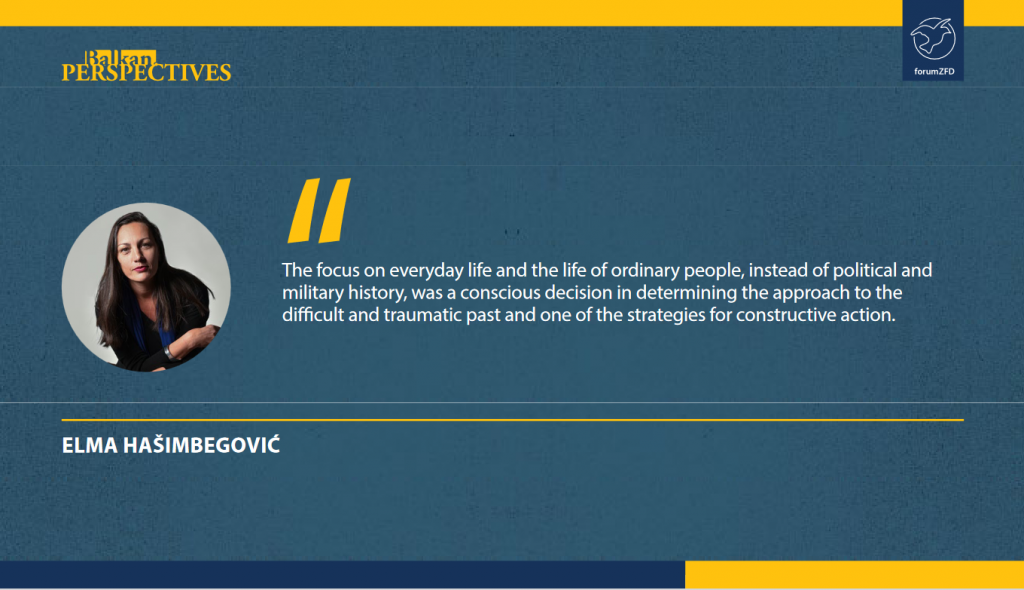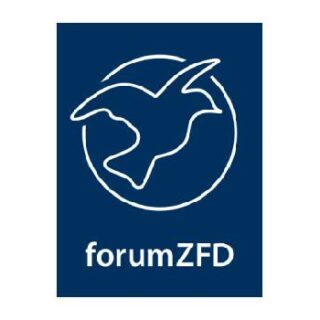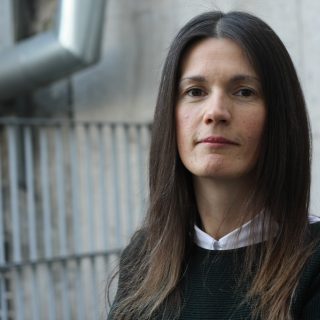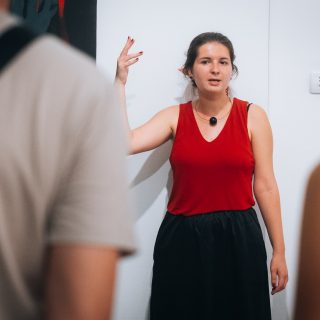(Based on a presentation titled “The Museum from the Front Line. The Power of Museums in Dealing with the Difficult Past: The Case of the History Museum of Bosnia and Herzegovina”, General Conference of ICOM, Prague, August 2022.)
“We used to be as you are, and you will be as we are now…”. I tried to awkwardly paraphrase the sign from the Bosnian medieval stone, while speaking to my colleagues from Ukraine at the annual international conference of ICOM (International Council of Museums). This year, the conference gathered in Prague over two thousand museum workers from around the world. The focus of the conference was on solidarity with Ukraine and on presentations about the endangered and destroyed cultural heritage in the war-torn country. It is a positive thing that the world museum community reacted to that social reality and paid attention to the topic of the war in Ukraine. Yet, it should be mentioned that the conference was not attended by museum staff from Russia, although there was no official ban on their participation. It was also touching to listen to our Ukrainian colleagues who – a bit naively for the experienced Bosnian ear (they still have time to become aware) – but with a lot of energy and engagement, spoke about the lost heritage, about endangered collections, about the need for documentation, mapping, rescuing, all the while expecting understanding and support from their international colleagues. I kept remembering “We used to be as you are, and you will be as we are now…”, and I could not help myself, so I added, “not only do we understand your present, but possibly we can also sense your future, because it probably won’t be peace; don’t rely too much on the international community, the question is what will happen to your museums and cultural treasures”, it just kept coming. However, the idea was not to spread defeatism, but to justify the invitation to the conference, which arrived with the aim of sharing the experience of how a museum that was on the front line in besieged Sarajevo, today uses museology to deal with that period, and how it works in the field of dealing with the past. But right at the start, as a result of self-reflection and constant questioning, completely legitimate and logical questions and dilemmas arise: is it even realistic to expect that museums can offer a different approach from what represents the dominant narrative for creating the political/national identity of a community? How much can museums, which are founded and supported by political elites that create memory politics and memorialization in post-conflict societies, really critically deal with the past? Can a museum really be at the service of society, as the new ICOM definition dictates, or is it simply more logical for it to be in the service of the state that feeds it? As all those questions clearly allude to a non-optimistic answer, the other question is: how much can a museum be a relevant factor in the society when it comes to the process of dealing with the past?
The Museum of People’s Liberation, later the Museum of the Revolution, and today the History Museum of Bosnia and Herzegovina, was founded with the aim of using the narrative of the World War II that had just ended, in serving the state in the process of building the identity of the new Yugoslav community. That narrative was based on the principles and values of anti-fascism, brotherhood, and unity of the people, i.e., togetherness and solidarity – positive values, but still it did not allow sensitive topics from the past to be opened and questioned, including everything that did not fit into the official policy of the Yugoslav state.[1] The moment the Yugoslav state disappeared, with all the tragic consequences of the wars In these spaces, the need for the existence of the museum that it had created ended with it. The Museum of the Revolution was left without a state, without a purpose of existence, and without support. But as much as museums as institutions are often sluggish and conservative, difficult to adapt or open to changes, it has been proven that when it comes to survival, they are extremely vital and actually outlive the systems, ideologies, and politics which founded them (most often if the successor system finds interest in the new function and role of the museum, and if it is even possible to make such a transformation). Such is the example of the History Museum of Bosnia and Herzegovina, which not only survived but also evolved, despite being abandoned by official policies. Or maybe because being abandoned by official politics. That factor turned out to be crucial for the institution to start looking for alternative possibilities and find a path that did not reject the past, but did not profit from it either. On the politics of openness, the transformation from “nobod’’s” to everyon’’s, i.e., into a museum for everyone, and the creation of a space for constructive dialogue about the past, the Museum has been patiently building its position and reputation as an institution relevant not only on the local level, but also on the regional and international scene.[2] Internationalization, i.e., reliance on international partnerships, exchange of knowledge and experiences with other post-conflict societies and their process of dealing with the past, greatly helped to get out of local, constraining frameworks and look at broader perspectives.

Over twenty years ago the History Museum of Bosnia and Herzegovina began working on the newer history of Sarajevo, and Bosnia and Herzegovina, more precisely the period between 1992 and 1995, making it a pioneer in the research and museology study of the siege of Sarajevo. As the successor of the museum which, since its foundation in 1945, has been engaged in the study and presentation of WWII for almost fifty years, the logical continuation of the work seemed to be focusing on the war in the nineties and collecting and researching new material. Thus, already in 2002, the collection and exhibition “Besieged Sarajevo” was created, and opened in April 2003. But only the starting point – the theme of war – was the same.Everything else was completely different. Unlike the master-narrative about the heroic fight in WWII, the exhibition “Besieged Sarajevo” focuses on the citizens during the siege, their everyday lives, creativity, strength and will to survive, on the cultural and civic resistance of individuals and collectives. It does this by presenting primary historical sources, authentic objects, photographs, documents and stories of citizens who donated objects to the museum. The focus on everyday life and the life of ordinary people, instead of political and military history, was a conscious decision in determining the approach to the difficult and traumatic past and one of the strategies for constructive action.[3] Collecting original objects and stories directly from the citizens of Sarajevo (later also from their family members, i.e., members of the second generation) about life under siege strengthens ties with the local community, strengthens the sense of belonging, participation, and ownership of the historical narrative. This type of process also has a therapeutic role and contributes to the healing of society.
Another important guideline in the process of working on sensitive topics, questions of genocide, atrocities, victims and perpetrators, is the reliance on established facts, used as evidence (for us, historical sources) in trials before the International Criminal Tribunal for the former Yugoslavia, the International Court of Justice and national courts, and researchers and partners engaged in archival research. One such example was the 25th anniversary of the genocide in Srebrenica. The slogan of the large regional campaign was “Srebrenica 25: together against the virus of denial”. It was led by one of the strategic partners of the Museum and perhaps the best expert on the work of the Hague Tribunal and archive, SENSE – Transitional Justice Centre, which brought together civil society organizations from Bosnia and Herzegovina, Croatia, Serbia, Montenegro, and Kosovo (the History Museum of Bosnia and Herzegovina was the only museum among the partners), which resulted in synchronized activities in the region and the exhibition “Srebrenica: Genocide in Eight Acts” in the History Museum of Bosnia and Herzegovina (and Pula). The use of documents, trial reports, materials testifying to how ICTY experts investigated, reconstructed, and prosecuted the crimes and genocide committed in Srebrenica, studied in the manner of museology, gave full legitimacy to the treatment of the topic and did not leave much room for manipulation, abuse, and denial.[4] Recently, the Museum has been engaging in independent research projects, relying on its own strengthened capacities, with the aim of covering certain topics from the recent history of Bosnia and Herzegovina. The most recent example is the treatment of the political history and the role of the institution of the Presidency of the Republic of Bosnia and Herzegovina between 1992 and 1995, presented through documents and other original materials at the exhibition “How to preserve a complete and multi-ethnic Bosnia and Herzegovina. The Wartime Presidency of the Republic of Bosnia and Herzegovina 1992–1995”, exhibited in the large gallery of the Museum in July of this year. A little earlier, the topic of international solidarity with Bosnia and Herzegovina and its citizens from 1992 to 1995 was processed as a topic in a similar way.[5]
Another important strategy that the Museum often applies in its approach is working with artists and using art in the process of dealing with the past.[6] There have been many examples of this, regardless of whether the artists were given the opportunity to work with historical sources and museum material (e.g. Vladimir Miladinović, Crvena collective, etc.) or sought their own artistic expression in order to open up some of the sensitive issues from the past (Adela Jušić, Lana Čmajčanin, Aida Šehović, etc.), or changed the perspective of looking at the war (exhibitions “Peace with a woman’s face”, “Art of anti-war” and others). It has been shown that the powerful and sensitized language of art provides a strong stimulus for reflection, and also has significant therapeutic power.
Turning back to the initial questions of power(lessness) of museums as institutions working in a given political and social framework, and as reflections of the situation in society, to tackle the topic of dealing with the past, the conclusion can be made that it is difficult to say and unrealistic to expect that museums can make a significant contribution to positive changes in society when it comes to these processes. However, there is always a smaller or larger area of freedom for action and it is a question of will and creativity how to obtain it and use it constructively. The History Museum of Bosnia and Herzegovina tries to use the conquered space of freedom for the benefit of the individual, the community, and the society in which it operates, believing that the experiences and work strategies can serve as an example for other communities.
Elma Hašimbegović is a historian and museum advisor, born in Sarajevo in 1977. She graduated from the Department of History at the Faculty of Philosophy in Sarajevo, and received her MA from the Department of Medieval Studies at the Central European University in Budapest. She completed her doctoral studies at the same university. Since 2001, she has been working at the History Museum of Bosnia and Herzegovina as a curator, participating in various projects and installations, including the permanent museum exhibition “Besieged Sarajevo (2002/2003)”. Since 2013, she has been the director of the History Museum of Bosnia and Herzegovina, developing and implementing new museum strategies and policies, actively promoting the museum as a place for research, education and constructive dialogue, and as a place open for everyone. She is the editor of the museum magazine Facts and Artifacts and other museum publications. She is an active member of international associations that work in the field of museology, education, and dealing with the past (Balkan Museum Network, Euroclio, Memory Lab, etc.). She was given the French award of Knight of the Order of Arts and Letters (Chevalier dans l’Ordre des Arts et des Lettres).
[1]The creation of the Open Depot within the Collection of Three-Dimensional Objects represents a symbolic step in opening up space for critical questioning of one’s own past and socialist heritage. About the Open Depot, see: Hodžić, Elma, “Promotion of cultural heritage through the concept of ‘open museum’: The Open Depot of the Historical Museum of Bosnia and Herzegovina as a space for critical questioning of socialist heritage”, Collection of articles – Association of Information Experts, Librarians, Archivists and Museologists, 9, 2017, 45-52.
[2] Several dissertations and articles have been written about the History Museum of Bosnia and Herzegovina in the light of its transformation and role: Selma Harrington, Other Modernism: Underpinning the Case of the History Museum of Bosnia and Herzegovina, doctoral dissertation (University of Strathclyde, 2020); Lana Balorda, Contested Heritage and Ethics of Care in the History Museum of Bosnia and Herzegovina, MA dissertation (Eberhard Karls University of Tübingen, 2022); Chrzová, Barbora. “Performing a difficult past in a museum: The History Museum of Bosnia and Herzegovina”, Slavia Meridionalis (19), 2019, 1-19; Harrington, Selma, Dimitrijevic, Branka and Salama Ashraf M. “Cracks and light: observing the Resilience of the History Museum of Bosnia and Herzegovina”, Martor 23, 2018, 143-161.
[3]Johanna Mannergren Selimović, “The Stuff from the Siege: Transitional Justice and the Power od Everyday Objects in Museums”, International Journal of Transitional Justice, 16/2, 2022, 220-234.
[4] https://srebrenica.sensecentar.org/
[5] “Wake up Europe. Mobilization of support and solidarity for Bosnia and Herzegovina and its citizens during the war 1992–1995”, is the name of the exhibition set up in the Museum in October 2021, on the basis of which a digital platform was later created www.wakeupeurope.ba
[6] Tiffany Fairey, Rachel Kerr, “What Works? Creative Approaches to Transitional Justice in Bosnia and Herzegovina”, International Journal of Transitional Justice 14/1, 2020, 142-164.




